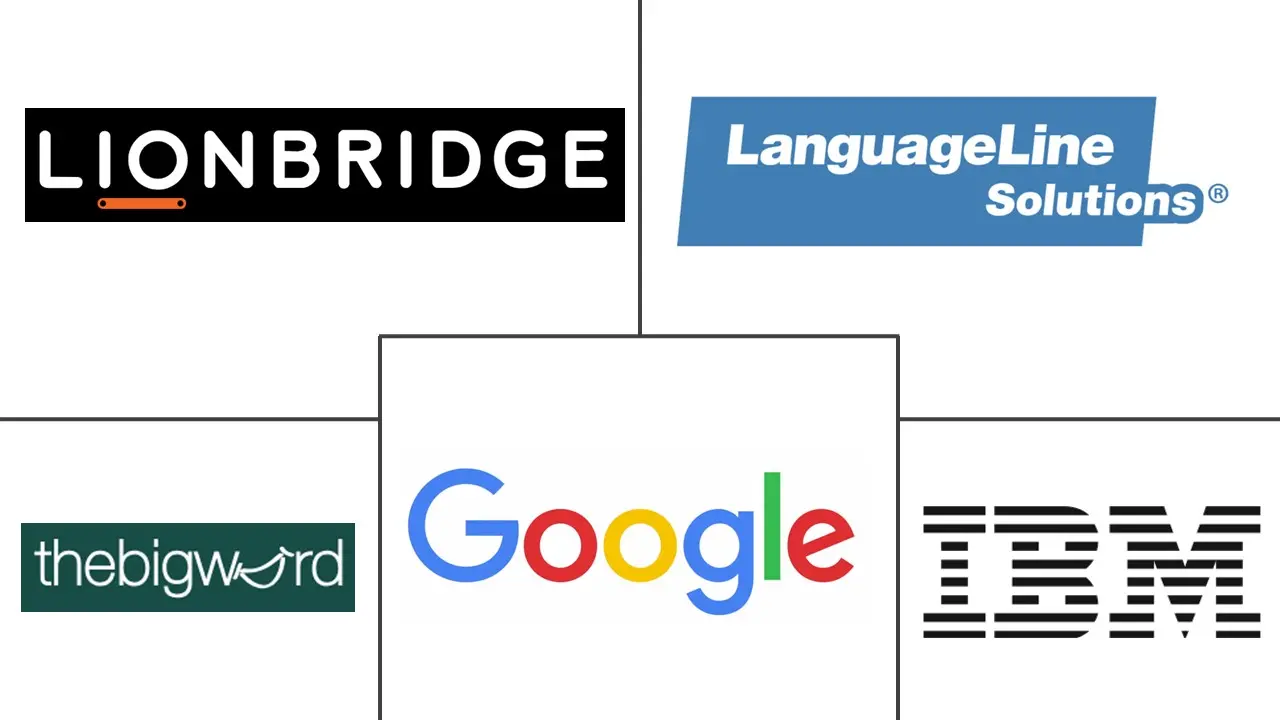Language Translation Device Market Size and Share
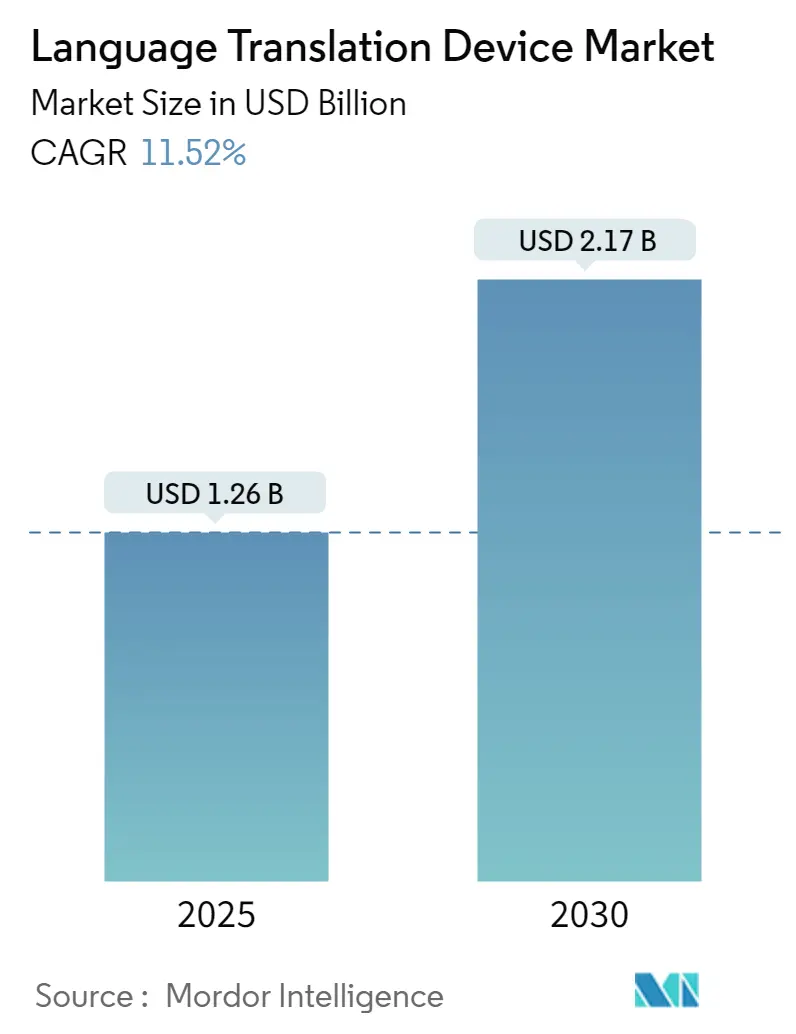
Language Translation Device Market Analysis by Mordor Intelligence
The Language Translation Device Market size is estimated at USD 1.26 billion in 2025, and is expected to reach USD 2.17 billion by 2030, at a CAGR of 11.52% during the forecast period (2025-2030).
- The growing international departures drill well for the language translating devices market as an increasing number of travelers are choosing destinations away from home with a different language. Moreover, the language translating devices market is experiencing tremendous technological transformations, revving sales of language instruments worldwide. Similarly, the increasing popularity of online information pursuits may boost demand for language translation software and services. Further, the increasing medical tourism is one of the main driving factors for the development of the target market.
- According to 10 Times, With over 33 thousand events published on an event platform from May 2022 to April 2023, the United States has the most conferences, business meetings, and trade exhibitions scheduled. The United Kingdom was the second-place finisher, which hosted 6.4 thousand events across all sectors. According to a recent study from LinkedIn, the largest professional network in the world, 45% of future B2B events will be entirely virtual. In the study of 200 B2B event organizers in the UK, 72% of companies want to continue hosting virtual events over the long term, and 77% are interested in hosting hybrid events. Such a huge number of events would drive the demand for the studied market.
- According to the Office of Travel and Tourism, Tourist Arrivals in the United States were 49,96,037 in June 2023. Further, as per Trading Economics, Tourist arrivals in Slovenia rose 10.6 percent year-on-year to 510,096 in May 2023, following a 16.6% growth in the prior month. Such a huge rise in the number of tourists would push the hospitality sector to adopt the latest Language translation devices to provide better services to its customers.
- Hybrid language translation hardware can perform translation operations in both offline and online modes. Such devices can work without network connections and enhance their capabilities through server-based operations. Moreover, in offline mode, hybrid devices can perform a small translation scale, whereas, in online or server-based connectivity, they can perform complex translations of speeches.
- For example, Lingmo International launched an IBM Watson-powered earpiece language translator to translate conversation without using the internet in a remote location like an airplane. It uses Watson Natural language programming, is priced at USD 179, and is useful for users ranging from travelers to the military.
- On the contrary, language translation devices rely on machine learning and artificial intelligence (AI) algorithms to deliver translations, with significant progress made towards reaching perfect accuracy and quality translations; yet reaching this goal remains difficult due to translating complex sentences, idioms, or context-specific phrases accurately proving difficult for machine translation systems, leading to potential errors and inaccuracies that compromise accuracy and quality in translations.
Global Language Translation Device Market Trends and Insights
Increasing Medical Tourism Driving Need for Language Translation
- The medical tourism industry is predicted to grow significantly in the coming years. With the advances in healthcare technology, increasing affordability, and increasing demand for technical treatments, more individuals are seeking medical services abroad, pushing the expansion of this market.
- The increased cost of health services in home nations directly affects market growth. In addition, the industry is being driven by increasing demand for techniques that are not insured, such as gender reassignment surgeries, reproductive therapy, dental reconstruction, and aesthetic surgery. Such growing factors of medical tourism would drive the demand for the studied market.
- According to the Medical Tourism Association's global medical tourism ranking based on 46 destinations, Canada came first with an index score of 76.47. The index is based on ratings of the destination environment, the medical tourism industry, and the quality of facilities and services. One of the medical tourism destinations is Canada. This would enable the healthcare sector to deploy language translation devices to understand the needs of patients from various regions.
- Healthcare facilities in developing countries seek international recognition from regulatory authorities, which can help them access global healthcare insurance and purchaser networks. Insurance companies in developed nations are incorporating health tourism policies in their medical plans to promote availing care services in foreign lands.
- Furthermore, a rapid increase in healthcare expenses coupled with many uninsured or underinsured individuals is encouraging tourists requiring medical treatment to help themselves with affordable healthcare services and treatments in developing nations. Such policies would push more medical patients to enter various regions for better treatment, creating a demand for the studied market.
- Moreover, this can be attributed to stringent European Union (EU)-wide requirements and regulations on medical procedures. Furthermore, medical specialists are being trained and educated to accommodate the needs of patients from various cultures, thereby fostering the demand for translating devices. This ensures that patients receive equally high-standard medical care throughout Europe in clinics providing specialized and innovative treatments.
- According to the Korea Health Industry Development Institute, a medical tourist is defined by the World Health Organization (WHO) as a person who travels across international borders to receive some form of medical treatment, most commonly dental care, cosmetic surgery, and fertility treatments. Americans made up the largest share of medical tourists to South Korea in 2022, at around 18 percent of inbound tourists, closely followed by mainland Chinese tourists. Such massive medical tourism would drive the market.
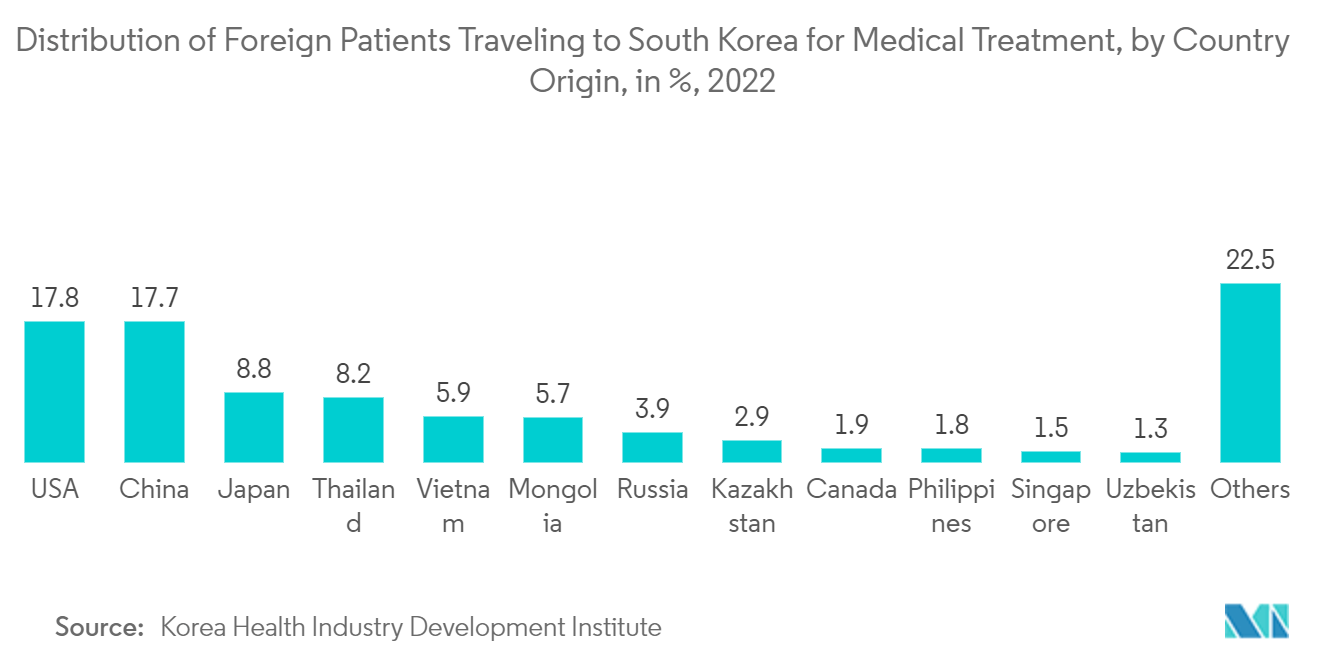
Europe is Expected to Hold Significant Share of the Market
- Europe is home to countries like the United Kingdom, Italy, Germany, France, Spain, and the Netherlands, which boast significant prominence in the healthcare, retail, and tourism sectors. The European Union consists of 27 member countries with 24 official languages. Moreover, according to WorldAtlas, Europe is the most visited continent.
- The region has the world's largest tourism intake, thus deriving significant revenue from the tourism industry. According to the United Nations World Tourism Organization (UNWTO), in 2022, the number of international tourist arrivals in Europe was 594.5 million, the highest compared to any other region. The sheer size of the tourism industry is expected to augment the region's demand for language translation devices.
- The European Union (EU) has active political and social ecosystems. With Brexit, the language barriers are expected to influence significantly, and English may not be one of the official languages in the EU. Finland Presidency of the Council of the European Union uses customized machine translation developed by Tilde. It set a record for using the translator by using the solution more than 600 thousand times and translating over 12 million words. Tilde's artificial intelligence (AI)-powered translators made over 1.4 million translations for the (EU) council presidencies.
- These translator devices are programmed to translate one specific language to another. The applications where these standalone devices are mostly used are transportation, sightseeing, Dining, and Shopping, and are more optimized for travel-related translation. Moreover, these translators are limited to words and phrases and are limited to a smaller number of language translations. Another limitation is that it uses only one-way translation. Moreover, the log bar is researching adding more multilinguistic features to its product illi.
- Furthermore, according to E-commerce Nation, Amazon was France's most popular e-commerce website, with over 164 million monthly visits. The French merchants Leboncoin and Cdiscount were second and third in monthly visits, with 142 million and 48 million visitors, respectively. According to the Federation of E-commerce and Distance Selling, online retailers in France generating over EUR 10 million (USD 11.8 million) annually constituted approximately 74.5% of the total e-commerce revenue during the pandemic. The increasing adoption of e-commerce platforms has led to a heightened need for language translation services.
- Owning to the fact that translation services play a key role in facilitating communication between users of different languages. These services encompass both spoken and signed communication and follow the International Standards Organization (ISO) definition that states the rendering of a spoken or signed message into another language by preserving the meaning of the source language content. The growing customer outreach has enhanced the scope of translation services to fulfill the customers' needs, barring language preferences. Historical data signifies that various companies are opting for translation services to provide comfort to their national and international clients. This would drive the studied market in the region.
- Translation devices usually require an integrated cloud computing platform and big data analytics to ensure data access from anywhere. This also results in increased storage capacity and more efficiency. With more and more companies offering their services online, the need for websites and web content translation has grown manifold. Businesses worldwide are seeking translation services intending to serve their customers and keep up with their demands. While individuals also use this type of service, the share of such usage is minimal.
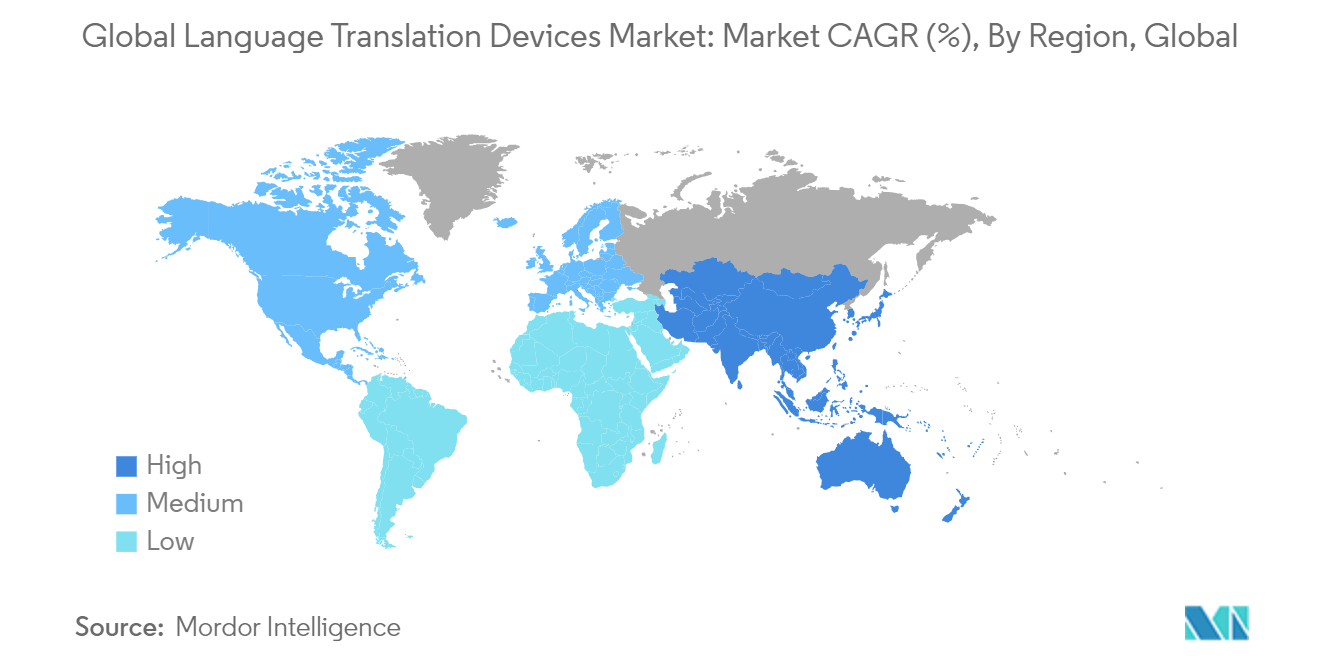
Competitive Landscape
The Global Language Translation Device market exhibits a moderate level of consolidation, featuring the presence of several key players such as Lionbridge Technologies, Inc., Bigword Group Ltd., LanguageLine Solutions, Google Inc., and IBM Corporation. These companies consistently invest in strategic partnerships and service development initiatives to secure a significant market share. Notable recent developments in the market include:
In May 2023, The Peiko Generation unveiled its innovative product, the "2 Wireless Translator Earbuds." These earbuds possess the remarkable capability to record and simultaneously translate up to 50 languages. Among the supported languages are Chinese, French, Spanish, Romanian, German, Portuguese, and Japanese. Users can employ these earbuds for one-on-one translations or engage in group conversations. When users speak, the words are automatically translated, displayed on their smartphone, and spoken aloud in the selected language.
In February 2023, Google Translate made significant advancements by incorporating AI-powered features. This includes the introduction of contextual translations, ensuring more accurate and contextually relevant translations based on the user's intent and the surrounding context. Additionally, the Android version of the application underwent a redesign, offering enhanced accessibility to voice input, conversation translation, and Lens camera translation. The introduction of new gestures also simplifies navigation within the app. Furthermore, Google Translate now leverages advanced machine learning for image translation, allowing it to translate intricate images and seamlessly integrate translated text into them, providing a more natural and cohesive appearance.
Language Translation Device Industry Leaders
-
Lionbridge Technologies, Inc.
-
Bigword Group Ltd.
-
LanguageLine Solutions
-
Google Inc.
-
IBM Corporation
- *Disclaimer: Major Players sorted in no particular order
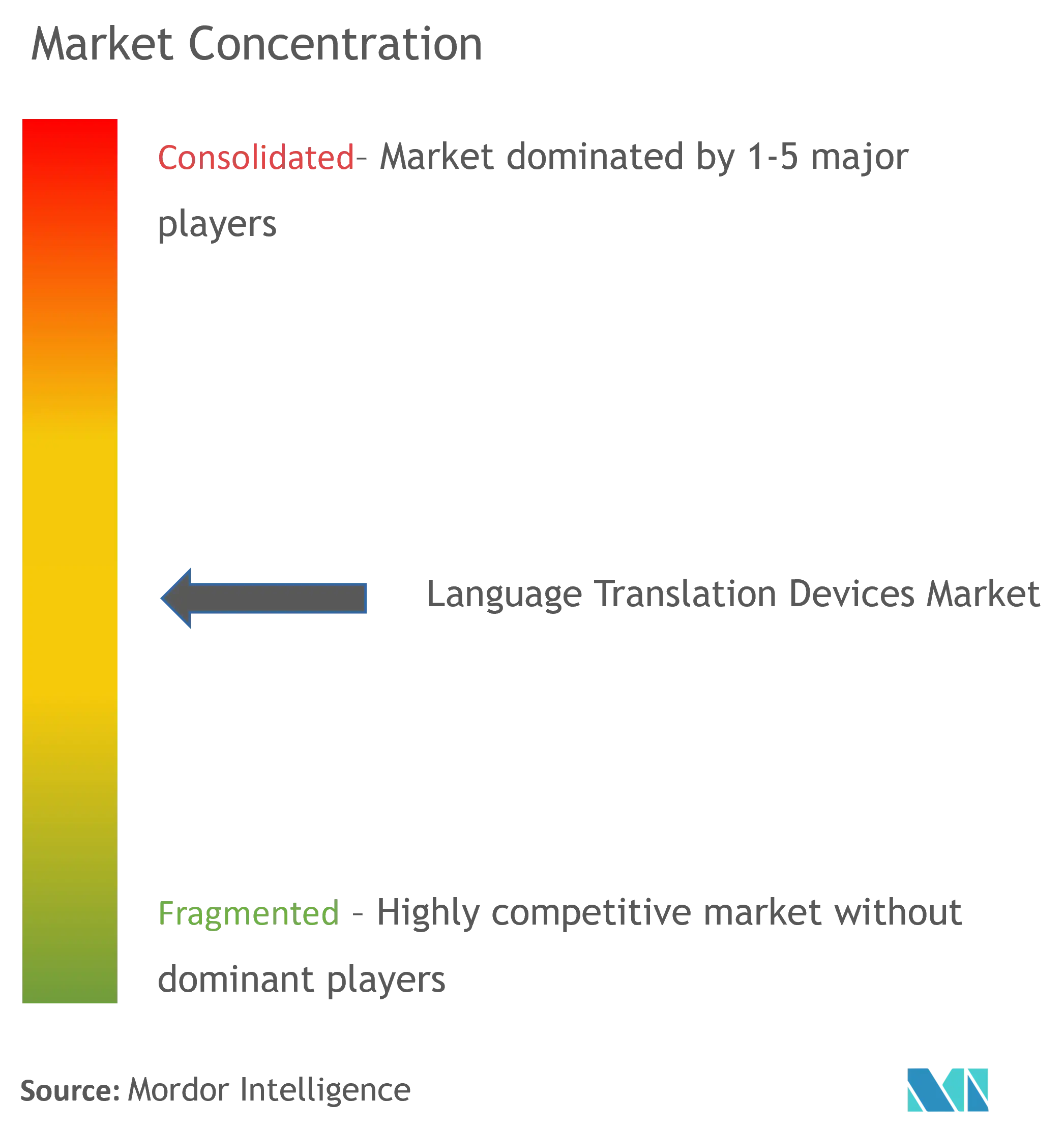
Recent Industry Developments
- March 2023: LanguageLine Solutions achieved ISO 9001:2015 certification for its Quality Management System, affirming its commitment to delivering top-notch speech services to clients in North America. As one of the world's premier providers of professional interpretation and translation services, LanguageLine continues to uphold the highest standards in the industry. ISO 9001:2015, a globally recognized quality management standard developed and published by the International Organization for Standardization (ISO), offers a blueprint for companies of all sizes and types to establish effective quality management systems.
- December 2022: Timekettle unveiled its cutting-edge translation technology, HybridComm, marking a significant advancement in the field. The company's Vector Noise Reduction (VNR) technology excels at pinpointing sound sources exclusively from the user's mouth direction, effectively eliminating unwanted noise and interference during conversations. Timekettle's innovative approach ensures that user voices are recorded in their entirety, maintaining clarity throughout the conversation. Furthermore, the company employs the RNNVAD voice recognition algorithm to automatically segment sentences, ensuring logical and seamless translations.
Global Language Translation Device Market Report Scope
A language translation device is a technology used to translate languages from one to another. Many types of language in the market contain simple phrasebooks and complex and complicated computer software programs. Among these devices, one of the most popular ones is an electronic translator.
The language translation device market is segmented by product type ( handheld, wearable) and geography (North America, Europe, Asia Pacific, Latin America, and Middle East and Africa).
The market sizes and forecasts are provided in terms of value USD for all the above segments.
| Handheld |
| Wearable |
| North America |
| Europe |
| Asia |
| Australia and New Zealand |
| Latin America |
| Middle East and Africa |
| By Product Type | Handheld |
| Wearable | |
| By Geography*** | North America |
| Europe | |
| Asia | |
| Australia and New Zealand | |
| Latin America | |
| Middle East and Africa |
Key Questions Answered in the Report
How big is the Language Translation Device Market?
The Language Translation Device Market size is expected to reach USD 1.26 billion in 2025 and grow at a CAGR of 11.52% to reach USD 2.17 billion by 2030.
What is the current Language Translation Device Market size?
In 2025, the Language Translation Device Market size is expected to reach USD 1.26 billion.
Who are the key players in Language Translation Device Market?
Lionbridge Technologies, Inc., Bigword Group Ltd., LanguageLine Solutions, Google Inc. and IBM Corporation are the major companies operating in the Language Translation Device Market.
Which is the fastest growing region in Language Translation Device Market?
Asia Pacific is estimated to grow at the highest CAGR over the forecast period (2025-2030).
Which region has the biggest share in Language Translation Device Market?
In 2025, the Europe accounts for the largest market share in Language Translation Device Market.
What years does this Language Translation Device Market cover, and what was the market size in 2024?
In 2024, the Language Translation Device Market size was estimated at USD 1.11 billion. The report covers the Language Translation Device Market historical market size for years: 2019, 2020, 2021, 2022, 2023 and 2024. The report also forecasts the Language Translation Device Market size for years: 2025, 2026, 2027, 2028, 2029 and 2030.
Page last updated on:
Language Translation Device Market Report
Statistics for the 2025 Language Translation Device market share, size and revenue growth rate, created by Mordor Intelligence™ Industry Reports. Language Translation Device analysis includes a market forecast outlook for 2025 to 2030 and historical overview. Get a sample of this industry analysis as a free report PDF download.
